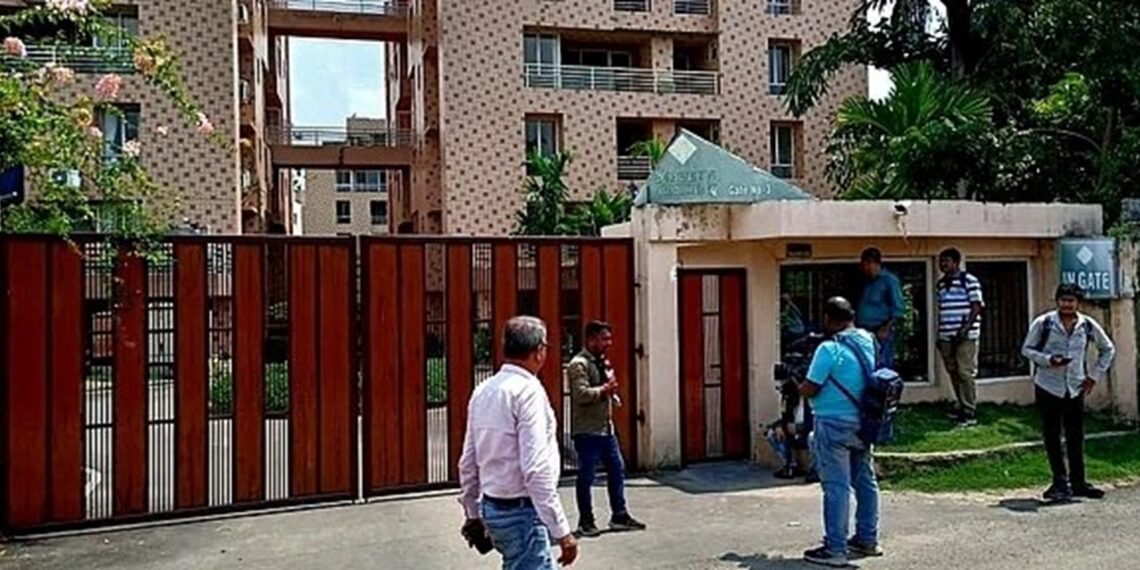A video released by the police – both Bangladeshi and Indian – investigating the alleged ‘murder’ of Awami League MP Anwarul Azim Anar in a Kolkata apartment last month violates all principles and tenets of crime scene sanctity and protection, bringing into sharp question the probe itself.
The video surfaced on June 12, nearly a month after the alleged murder at a plush apartment in Sanjeeva Garden society in Kolkata’s New Town neighbourhood.
The video shows Bangladesh Detective Branch and West Bengal CID officers recreating the alleged ‘murder’ in the presence of Jihad Howladar, one of the four persons accused of taking part in dismembering, destroying and disposing of Anar’s body.
Northeast News took the assistance of a former top forensic science expert in Kolkata to seek his comments and list his observations on the video and the storyline being put out by the police investigating units of Bangladesh and West Bengal.
The expert preferred anonymity since he has previously worked with the CID when in service. The following are his observations:
1) Prima facie, the police version of the ‘murder’ and the video suggest this “to be a case of fabrication”.
2) The act of recording a video violates the sacrosanct principle that a crime scene should remain protected and sanitised – and not willfully violated – till such time that the case does not reach trial stage.
3) The entry of so many people — including DB officers and a person recording the visit — into the so-called crime scene would wipe out “trace evidence” such a blood spots, hair strands, fingerprints etc.
4) None of the officers or even the person recording the video is seen wearing protective clothing such as gloves etc.
5) At least two officers, said to be Bangladesh Detective Branch sleuths, are shown prompting Howladar to “say” what they wanted said. Such prompting included asking leading questions, stating the version as narrated to them by another accused Shimul Bhuiyan alias Amanullah. They asked “leading questions” to Howladar.
6) In the video the police officers take the names of all the three individuals – Shimul Bhuiyan, Tanveer Bhuiyan alias Faisal and Celeste Rahman – to highlight the role of each of them in the events that supposedly unfolded in the apartment. Why did they miss naming another key person in the alleged ‘murder’ conspiracy, 31-year-old Mohammad Siyam Hossain who reached the apartment from Nepal before the murder and left for that country on May 19?
7) Did CID officers collect trace evidence of the accused persons who lived in the apartment for several days before May 13?
8) Why did the police not ask Howladar about Siyam’s role in the series of events leading to the alleged ‘murder’ and dismemberment of Anar’s body?
9) One police officer is seen bending downward, in the toilet where Anar’s body was supposedly chopped and deboned before some portions of his flesh were allegedly flushed down the commode. He is heard saying in Bengali, “this is how he (Anar) was placed on the floor, right?”
10) The floor tiles would have suffered extensive damage as a result of the blows (by a cleaver) on a human body. And yet the bathroom floor was intact. There is no evidence that Anar’s body or parts of its was placed on a wooden block to absorb the shock of the cleaver blows.
11) The person who took the video used West Bengal dialect of Bengali, suggesting he is either a CID officer (which is unlikely) or a video-journalist. Should he have been allowed into the crime scene?
12) The toilet appeared to be too cramped a place to undertake the grisly operation to chop, dismember and debone a fully-grown adult body. Such actions would have left traces of blood on the walls. No such blood traces were shown in the video.
13) A turquoise trolley suitcase, allegedly used to carry Anar’s body parts, is not large enough to carry flesh pieces belonging to a fully grown adult.
14) Along with the video, a separate still photo went viral on June 12. This photo shows Anar tied with ropes and other clothing in a swivel chair. His arms are tied to the chair’s arm rests. His head and chest were held back firmly by two separate pieces of clothing. And he was gagged. Anar was naked. But the photo, as put out by someone in Bangladesh DB, had been cropped and photo-shopped.
15) The body tied to the chair appears to be “too fresh” with no signs of bruises or abrasions on his face, chest or belly. Asphyxiation or smothering causes the eyes to pop out, but in Anar’s case – considering it was his body in the chair – the eyes were partly shut. Besides, the body was not “lustreless” following death by asphyxia or smothering. And the gagging was not quite gagging since his nostrils were not covered.
16) While it is understandable why only Anar’s torso and not the lower part of his body – genitals etc – was shown, what does not make sense is why other elements of the photo such as objects and scene around had to be photo-shopped, and that too crudely, before it was put out in public?
17) The original version of this photo seems to be one among some others which were shared by Shimul Bhuiyan with Jhenaidah Awami league leader Kazi Kamal Ahmed Babu who in turn allegedly shared it on WhatsApp with Saidul Karim Bhuiyan, the party’s district general secretary.
18) If this photo was taken inside the Sanjeeva Garden apartment, Howladar would certainly have either taken part in tying and gagging Anar or been a witness to the process. The DB and CID officers neither made any mention of this part of the crime nor was the chair to which Anar was tied shown, although the bed on which he lay sprawled after being made unconscious was shown.
19) Could it be that Anar was tied to a chair in another location which the police are not disclosing?
20) The CID had earlier claimed that blood spots were found in some part of the apartment? They, however, did not make clear in which room of the apartment the blood spots were found. Why were these blood traces not shown in the video?
21) It has been a month since Anar was allegedly ‘murdered’ and yet the police have not been able to trace the heavy cleavers and sharp-edged knives that were supposedly used to chop his body, including the bones, and hacked into small pieces. While some bones have been ‘recovered’ from the Bagjola storm water drain near Bhangar, there is no trace of the cleavers and knives.
22) The bones recovered appear to be of a human but they are “not fresh”.
23) The bones, especially ‘ball’ part of an upper arm, recovered from the Bagjola canal had no cartilaginous substance around the edges. Decomposition and liquification of the joints take at least six months, if not more.
24) How is it that more complex bone formations such as the hip bone, femur (thigh bone), patella (knee cap), tibia (larger shin bone) and the fibula (smaller and relatively thinner bone located below the patella) have not been found so far? More importantly, where is the skull?
25) None of the persons arrested so far, including Howladar, Siyam and Shimul Bhuiyan, has ‘revealed’ to the police the whereabouts of the weapons although the DB sleuths have been able to trace the murder to Mintu and Akhtaruzzaman Shaheen. This is not only strange but baffling.
26) The police seem to be too eager to ‘explain’ only parts of the motive and the links of political personalities in Jhenaidah to the alleged ‘murder’. And yet there is no evidence to suggest that efforts are being made to trace the ‘murder’ weapons. If the arrested persons are singing, should it not be that they would as readily tell the investigators about the weapons’ whereabouts?
On the other hand, Anar’s daughter Mumtarin Ferdoush Doreen claimed on June 12 that Awami League Jhenaidah district Joint Secretary Kazi Kamal Ahmed Babu was “on good terms” with her father and that she would address the other arrested party leader, Saidul Karim Mintu, as “chacha” or uncle.
Doreen vowed to pursue the investigation so that it does not get deflected or derailed.















